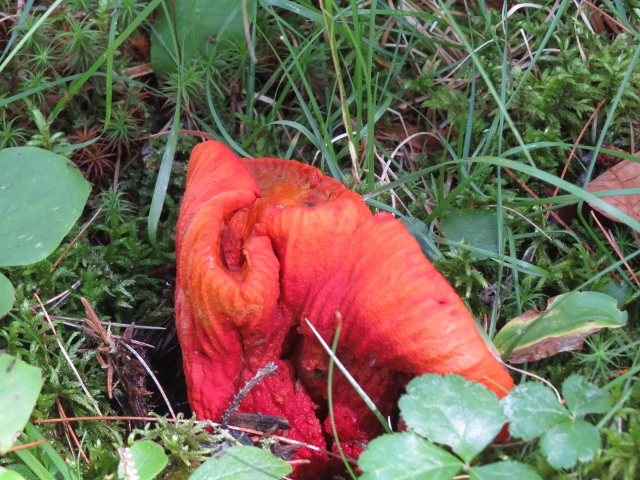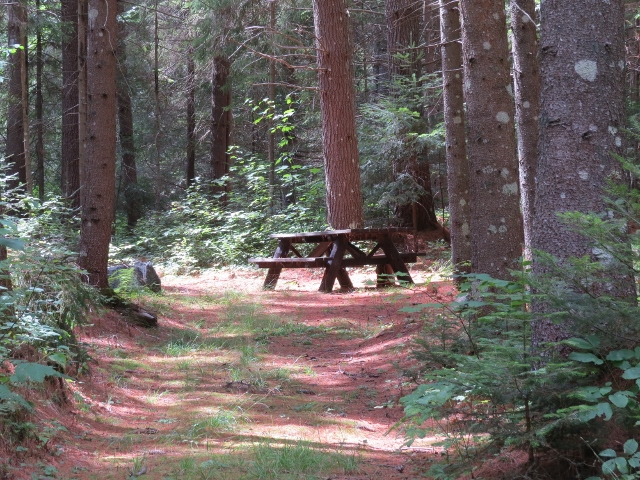The Roosevelt Truck Trail in Minerva is one of the most beautiful trails in the Adirondack Park. The road-sized path takes hikers through a lovely, mature boreal forest of spruce and balsam fir trees on a carpet of sphagnum moss.
The 2.5 mile long trail has become a favorite hike during the annual Adirondack Birding Festival.
Flora and Fauna
Year-round boreal birds, such as Black-backed Woodpecker, Canada Jay, and Boreal Chickadee can be found along the Roosevelt Truck Trail.

During the spring, it is one of only a handful of known nesting locations in the Adirondacks for the sought-after Cape May Warbler.

In the fall and winter, both year-round and irruptive finches can be found along the trail if the cone crop is good. With an excellent cone crop this year, Red Crossbills have already made their way into this area.

Wildflowers, lichens, mushrooms, amphibians, and mammal tracks are just as exciting as the birdlife along the Roosevelt Truck Trail! Black bear and moose tracks are often spotted along the path.
August Field Trip
I recently led an August field trip along the Roosevelt Truck Trail. The Long Lake “Little Bus” dropped us at the northern trailhead along the Blue Ridge Road in dense fog conditions.

One of the first birds we found was a female Black-backed Woodpecker!

A few Boreal Chickadees were also found. A total of 9 Boreal Chickadees were tallied this day along the trail.

Several Hermit Thrushes and one Swainson’s Thrush were also found early in our hike.
More than a dozen wildflower species were found during our trip and the first one encountered was the lovely Blind Gentian.

Blueberries were abundant as we hiked the beginning of the trail – as was the black bear scat!
The trail has gradual uphill sections in the first couple tenths of a mile before a steeper downhill section around the half-mile point. Vanderwhacker Brook is crossed on a wooden bridge at the bottom of the hill.

The wide diversity of fungus along the trail was an attraction for everyone.







Spotted Touch-Me-Not, a favorite food of Ruby-throated Hummingbirds, and Turtlehead wildflowers were found in a wetland area near a stream.


After crossing Vanderwhacker Brook, the trail has gradual uphill and level sections before the first of two wheelchair-accessible camp areas is reached. We took a food break at the camp site picnic table. The camp sites are roughly the half-way point of the 2.5 mile long route.

The trail has a few more gradual uphill sections before a series of downhill areas end at the southern trailhead parking area.

As we hiked the second half of the 2.5 mile long trail, we spotted Eyebright, a tiny little wildflower that could easily be overlooked!

A feisty Winter Wren, one of several found, called loudly at us! Golden-crowned Kinglets and Red-breasted Nuthatches were abundant along the trail. Several late summer “warbler waves” were encountered and included, Ovenbird, Magnolia, Blackburnian, Black-throated Blue, Yellow-rumped, and Black-throated Green Warblers.
As we neared the trailhead, we heard chainsaws. The local forest ranger and a crew were clearing blown-down trees from the trail. The Roosevelt Truck Trail is a popular cross-country ski route in winter. In summer, those with physical disabilities can gain access through the metal gate and drive to the camp sites, so the trail receives regular maintenance.
Just before we reached the trailhead, one of the participants commented on a huge White Cedar tree at the edge of the trail. Thomas Cullen stood in front of the tree for perspective on its size!

The Long Lake “Little Bus” was waiting for us as we arrived at the southern trailhead parking area located off Route 28N.
How to Reach the Roosevelt Truck Trail
The 2.5 mile long Roosevelt Truck Trail runs in a north-south direction between the Blue Ridge Road and Route 28N. To reach the Roosevelt Truck Trail southern parking area, proceed .3 miles south of the railroad tracks on Route 28N to the paved road east of the highway – it looks like a driveway! Often, hikers decorate a pole near this drive (currently there are 3 American flags in the pole!). Drive in the bumpy paved road for a few hundred feet to where it ends, and park without blocking the gated trail. From the opposite direction, the paved road is 1.6 miles north of the Boreas River Bridge. To reach the northern end of the trail, take the Blue Ridge Road 4.3 miles east from its intersection with Route 28N to the trailhead on the south side of the road, or 10.5 miles west of the Elk Lake Road. The northern trailhead is on a curve and difficult to spot. There is also a metal gate at this end of the trail and stone walls on either side.
With two cars, one at each trailhead, the trip can be a 2.5 mile thru-hike. Otherwise, the round trip is 5 miles.
When you visit, you will find comfortable lodging and restaurants in a beautiful wilderness setting!




